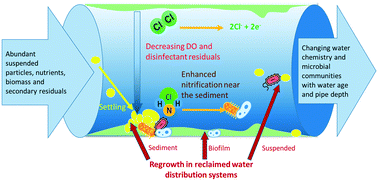Sediment and biofilm affect disinfectant decay rates during long-term operation of simulated reclaimed water distribution systems†
Abstract
Changing chemistry and microbiology of reclaimed water as it is conveyed via reclaimed water distribution systems (RWDSs) can influence water quality at the point of use. Two simulated RWDSs comprised of 0.32 cm tubes (“Tube” RWDSs) and 10 cm diameter pipes (“Pipe” RWDSs) were designed to investigate how extremes in water age (32 min versus 5 d) and surface area to volume ratio (6.25 cm−1versus 0.20 cm−1) affect the potential for sediment accumulation, disinfectant decay, and chemical and microbial water quality under controlled treatment conditions. Effluent from a conventional municipal wastewater treatment plant was breakpoint chlorinated and treated with and without biological filtration, followed by three disinfectant conditions: no residual, 4 mg L−1 chlorine or 4 mg L−1 chloramine. After three years of operation, accumulated sediment occupied 0.32–3.2% of the total volume of the first pipe segment. The unfiltered chlorine condition had an order of magnitude less influent turbidity and sediment accumulation than conditions with no residual or chloramine, resulting in lower levels of biological activity and slower depletion of disinfectants and dissolved oxygen. The sediment in pipes receiving chloraminated water was highly biologically active and created a high disinfectant demand due to nitrification. In contrast, the tube RWDSs did not accumulate sediment. The Tube rigs with chloramine and no residual had heavy bio-foulant growth, which resulted in rapid depletion of chloramine. Biofilm was the main source of disinfectant demand in the chlorine tubes. An improved holistic understanding of RWDSs chemistry, biology and operation will help achieve desired water qualities at the point of use.



 Please wait while we load your content...
Please wait while we load your content...
